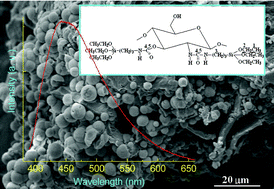Functional nanostructured chitosan–siloxane hybrids
Abstract
New organic–inorganic hybrids were prepared by a sol–gel method from the

- This article is part of the themed collection: Functional hybrid materials
* Corresponding authors
a
3Bs Research Group – Biomaterials, Biodegradables and Biomimetics, University of Minho, Campus de Gualtar, Braga, Portugal
E-mail:
simonesilva@dep.uminho.pt
Fax: +351 253604492
Tel: +351 2536044781
b Department of Polymer Engineering, University of Minho, Campus de Azurém, Guimarães, Portugal
c Department of Physics, CICECO, University of Aveiro, Aveiro, Portugal
d Department of Chemisty, CICECO, University of Aveiro, Aveiro, Portugal
New organic–inorganic hybrids were prepared by a sol–gel method from the

 Please wait while we load your content...
Something went wrong. Try again?
Please wait while we load your content...
Something went wrong. Try again?
S. S. Silva, R. A. S. Ferreira, L. Fu, L. D. Carlos, João. F. Mano, R. L. Reis and J. Rocha, J. Mater. Chem., 2005, 15, 3952 DOI: 10.1039/B505875A
To request permission to reproduce material from this article, please go to the Copyright Clearance Center request page.
If you are an author contributing to an RSC publication, you do not need to request permission provided correct acknowledgement is given.
If you are the author of this article, you do not need to request permission to reproduce figures and diagrams provided correct acknowledgement is given. If you want to reproduce the whole article in a third-party publication (excluding your thesis/dissertation for which permission is not required) please go to the Copyright Clearance Center request page.
Read more about how to correctly acknowledge RSC content.
 Fetching data from CrossRef.
Fetching data from CrossRef.
This may take some time to load.
Loading related content
